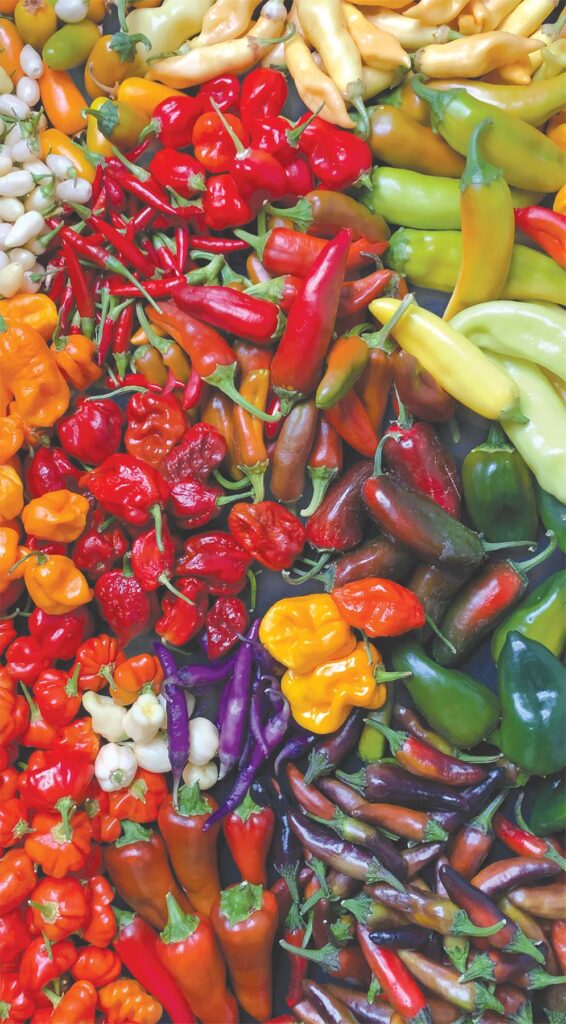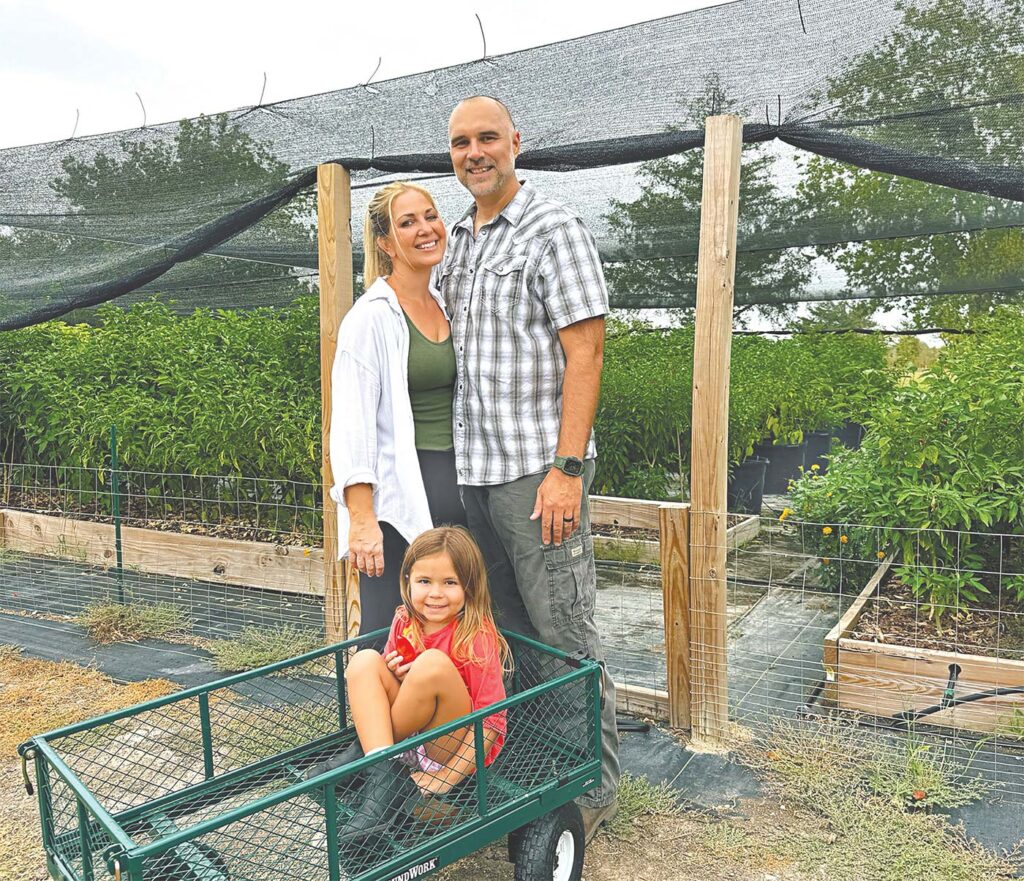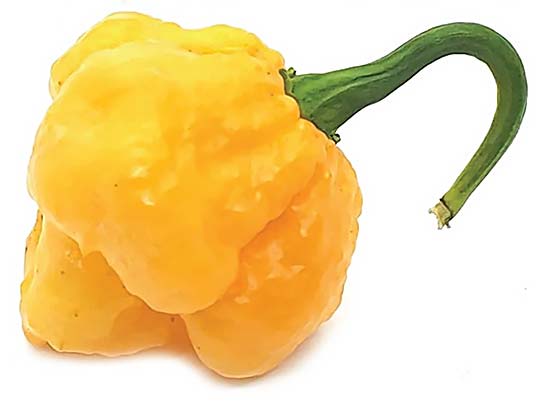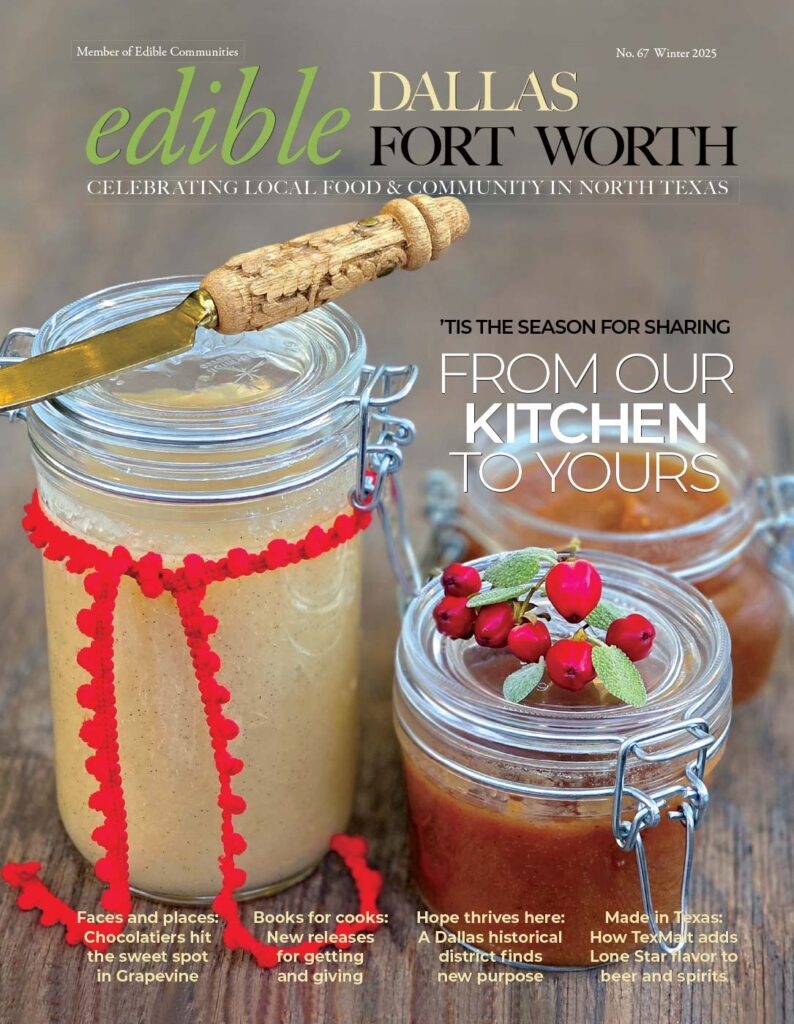
Summer brings the heat in more ways than one. Celebrate the season with a diverse selection of spicy and sweet.
When summer’s heat dome settles over North Texas, gardening can be downright brutal. But then comes the silver lining of a different kind of heat: peppers take their place in the season’s spotlight. They hit their stride just as the temperatures become unbearable, often peaking between mid-July and early September when the days are long, the nights stay warm and these fruits (yes, like tomatoes) can start to outpace your ability to harvest.
Can’t take the mouth-searing fire of a jalapeño or ghost pepper? Not to worry. You might be surprised by the diversity peppers offer, with every imaginable color and shape. Some lean sweeter, perfect for gardeners who prefer a gentler bite. But for me, what’s even more fascinating is that the dozens of varieties grown in the region each tell a story—of cuisine, soil and living history passed down season after season.
Even here, in the metropolis of North Texas—tucked between highways and hayfields and across the urban and rural divide—two growers are making sure those stories are heard … and tasted.

PEPPERONA PEPPERS: A COUPLE SELLS SPICY AND SWEET
At the Dallas Farmers Market, the Pepperona Peppers booth is one of the busiest, with bowls overflowing in a rainbow of pepper shapes and colors beyond red or green. Some glow white, yellow, orange, pink, purple—even stripes. This Greenville, Texas, farm also sells starter plants, small-batch sauces, jellies, spicy “fire” cider and a vibrant mix of vegetables, herbs and fruit.
Casey and Verona Widboom didn’t set out to be pepper enthusiasts. Casey grew up on a Minnesota farm that represented generations of family knowledge. Verona was raised across the Middle East and Southeast Asia with her missionary family.
“These lived experiences contributed to our diverse lineup of products, international flavors, unique produce and the love of growing uncommon varieties of peppers,” Verona says.
Because they have grown “almost every capsicum species known” and change their crops each year, their planting decisions are shaped both by curiosity and conversation. “Selling face-to-face, we see what customers are looking for, what they like and what they can’t find—and we try to fill that need,” says Casey.
Each season brings new crosses with unexpected colors, flavors, shapes and heat levels. They also grow a wide range of heirlooms, which Verona notes are often more prolific, higher-yielding and naturally pest resistant.
The varieties they choose to grow reflect global influences: Red Dragon (China), Sriracha (Thailand), and Aji peppers (Latin America). “It may just be that we have a pepper plant someone has always wanted to grow,” Casey says, “a pepper they haven’t eaten since they lived back home.”
But some peppers are also grown partly for their cool factor—an experimentation with plants they’ve each grown to love. “If we’re growing jalapeños, you bet they’re gonna be something like an Orange, Lemon or Multi-colored jalapeño,” they say.
That same curiosity leads them to celebrate not just the fruit, but the whole plant. The cooked leaves of many pepper varieties are not only edible, they’re delicious, they say, adding a more subtle spice to stir-fries and soups. And while their crops are culinary, they underscore the health benefits of capsaicin, the compound that gives peppers their spiciness. “We were told recently by a local cancer researcher that the hottest pepper in the world, Pepper X, is currently being used in cancer research,” Verona says.
KHANGSTARR: THE MAD SCIENTIST OF PEPPERS
Just up the road in Fannin county, a different kind of pepper patch grows. At KhangStarr Farms, a sustainable mix of cattle, fruit trees and peppers share the land. Though Khang doesn’t sell his harvest—breeding and growing peppers instead for fun—seeds from his peppers have made it far beyond Texas and are currently being grown across the globe.
Most well known for his Facebook group and YouTube channel, Khang is also well known in pepper forums and social media communities across the globe, appearing online only as “KhangStarr.”
This pepper influencer’s love of growing also began early. “Every summer, I’d stay with my grandparents and help them on their farm [in Vietnam],” he says. “Peppers in particular were a staple; they’re a key ingredient in much of our cooking,” he says, of his culinary heritage.
Khang’s pepper varieties are prized by pepperlovers internationally not only for their unique shapes and complex fruity-spicy flavors but also because they are vigorous growers and producers. Rather than profit, his focus is on creating new varieties bred himself to suit his personal tastes. Some, such as KS Lemon StarrBurst, KS Scarlet Rose and KS White Thai, are key ingredients in the seasonal hot sauces he makes in batches destined for family and friends.
The latter was inspired by his family’s deeprooted Thai cuisine, though Khang’s ivorycolored version has a cleaner, crisper heat with subtle citrus notes. It’s also described as having less earthiness than traditional red Thai chilies. “When I began using it in place of the traditional Thai pepper, it completely transformed my dishes,” he says.
Arguably his most beloved creation (each identified with his “KS” moniker) is now being grown from Sweden to South Africa, Brazil to Japan—prized for its balanced spice level and lemon-zest undertones. “The KS Lemon StarrBurst is large and round, with a distinctive flying saucer shape and a unique stinger at the tip, [and] easily surpasses the heat of a habanero,” Khang says. You can even track this North Texas-bred pepper’s journey, charted by fans through a shared online map pinpointing each locale.
Khang shares seeds freely to those in his online Facebook community, “Pepper Lovers,” and encourages others to grow—and even to sell—his peppers. He values beauty and heat but also champions his personal favorites that might not get as much recognition. “The KS Brazilian Starfish is sweet and flavorful with just a subtle kick of heat every now and then—it’s almost like eating a fruit,” Khang says. For would-be pepper growers just starting out, his advice is simple: “Don’t worry about making mistakes, that’s part of the process. The biggest mistake you can make is not starting sooner.”


SOURCES
Where to find seeds, seedlings and small-batch products from the farmers behind the heat (and sweet):
PEPPERONA (local grower, North Texas markets)
This boutique grower sells live starter pepper plants and products at the Dallas Farmers market, in addition to other markets and events across North Texas.
- Instagram @pepperona.tx
- Online shop Pepperona.com
KHANGSTARR (backyard breeder and online pepper guru)
Khang doesn’t sell peppers to the public, but his seeds are available from his website and for free/swap on his Facebook group, Pepper Lovers. His Instagram page and YouTube channel feature breeding projects of other fruits and vegetables.
- Instagram and YouTube @khangstarr
- Online shop TexasHotPeppers.net

PEPPERS WITHOUT BORDERS
In Texas, native chile pequins have long grown wild, thriving in the dappled light beneath mesquite and oak—tiny fireballs of spice.
Across the globe, peppers have traveled by trade, migration, seed swaps and backyard curiosity— taking root in North Texas with remarkable ease. From Mexico, we get jalapeños and serranos for salsas and poblanos for stuffing. Tabasco (Louisiana by way of Mexico) fuels the South’s most iconic hot sauces. From Peru, Aji Rico and Aji Amarillo bring citrusy heat to ceviches and stews.
From Asia, we blister Shishito peppers (Japan) for appetizers, crush Bird’s Eye Thai (Thailand) into curry pastes and can grow the red chilis that inspired American Sriracha (Thailand). The vivid Chinese Five Color (China) peppers are often grown for ornamental flair, adding heat and color to gardens.
From India, the Bhut Jolokia (Ghost Pepper) brings intense heat— once crowned the world’s hottest. Not far behind, the Trinidad Scorpion (Trinidad & Tobago) earns its name with a searing sting. Gochu peppers (Korea) are made into fermented pastes such as gochujang and are essential in kimchi. From Europe, Spain gives us the variable heat of Padron and the sweet heart-shaped Pimiento. Hungary delivers Hungarian Wax and Paprika, which is traditionally dried and ground. Greece brings Pepperoncinis, golden green and perfectly tangy when pickled. Italy spawned the Corno di Toro Rosso and Giant Marconi peppers which flourish in North Texas.
From the United States, we celebrate the Carolina Reaper (South Carolina), bred from Caribbean and South Asian stock to top the Scoville charts. And in Texas, no garden feels complete without the Hatch chile, developed in New Mexico from Mexican and Peruvian roots and roasted into everything from salsas to stew. Over time peppers have learned to thrive on rocky hillsides, in humid jungles and even in deserts. Here in North Texas, they find common ground in our challenging soils and punishing summers, bringing rewards for gardeners bold enough to endure the heat.
No matter where they start, peppers—and people—find ways to grow and flourish together.
TIPS FOR NEW PEPPER GARDENERS
In Texas, gardeners get two chances to plant peppers, ideally transplanted as young starter plants. The first comes in early spring after the last frost for a summer harvest, with a second opportunity arriving in the second half of summer, which gives plants just enough time to produce before the first freeze sets in. Our sources offer advice.
PEPPERONA PEPPERS
- Harden off seedlings outdoors before planting.
- Use compost-amended, welldraining soil.
- Apply 30 percent shade cloth during the hottest months and mist plants in dry spells to reduce heat stress and improve fruit set. KhangStarr Farms
- Start a small pepper patch and start now—waiting is the most common mistake.
- Focus on soil health. “Feed the soil and the soil will feed your plants.”
- Learn by doing. Mistakes are part of the growing process.
10 PEPPERS WORTH GETTING YOUR HANDS DIRTY FOR
VERY HOT
- KS Hornet (KhangStarr)
- Star Scream (Pepperona)
- KS Lemon StarrBurst (KhangStarr)
MEDIUM HEAT
- Sriracha (Pepperona)
- Sugar Rush Peach (Pepperona)
- KS White Thai (KhangStarr)
- KhangStarr Peach StarrKist, pictured below (KhangStarr)

SWEET OR MILD
- Pepperoncini (Pepperona)
- Jalapeños: Orange and multi-colored (Pepperona)
- Brazilian Starfish (KhangStarr)
Daniel Cunningham, Horticulturist with Texas A&M AgriLife's Water University program. His primary focus is a holistic approach to landscaping and food production systems. Cunningham specializes in Texas native plants and trees, vegetable gardening, edible landscaping, rainwater harvesting and is passionate about utilizing landscapes as habitat for benecial wildlife. For more gardening advice om Daniel, tune in to NBC DFW (Channel 5) on Sunday mornings or ask @TxPlantGuy on Facebook, Twitter or Instagram.
- Daniel Cunningham
- Daniel Cunningham
- Daniel Cunningham
- Daniel Cunningham





